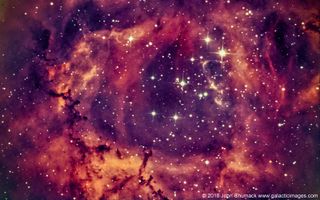A Valentine 'Rose': Superhot Stars Glow in the Rosette Nebula's Heart (Photo)

Happy Valentine's Day… from space!
A cluster of superhot stars glows in the core of the Rosette Nebula in this deep-space image by astrophotographer John Chumack.
The Rosette Nebula is a rose-shaped cloud of interstellar dust and gas that lies about 5,000 light-years away in the constellation Monoceros (the Unicorn). At the center of the flower's cosmic petals is a cluster of stars known as NGC 2244, or Caldwell 50. This star cluster also contains several rare blue-white O-type stars, which are some of the hottest and brightest stars in the universe.
These short-lived stars arose from the very clouds in which they reside after regions of that cosmic dust and gas collapsed onto itself. After a few million years, these stars explode as supernovas, unleashing all their energy and flinging more "star stuff" back into the Rosette Nebula. [Valentine's Day in Space: Cosmic Love Photos]
Surrounding these enormous, bright stars are darker splotches known as Bok globules. These small, dense clouds of dust and gas are some of the coldest places in the universe. They appear dark because they absorb the light from the more luminous background.
Chumack captured this image from his backyard observatory in Dayton, Ohio, using a ZWO 174-millimeter cooled CMOS camera and a 6-inch Newtonian telescope.
You can see more amazing night-sky photos by our readers in our astrophotography archive here.
Get the Space.com Newsletter
Breaking space news, the latest updates on rocket launches, skywatching events and more!
Editor's note: If you have an amazing night sky photo you'd like to share with us and our news partners for a possible story or image gallery, please contact managing editor Tariq Malik at spacephotos@space.com.
Email Hanneke Weitering at hweitering@space.com or follow her @hannekescience. Follow us @Spacedotcom, Facebook and Google+. Original article on Space.com.
Join our Space Forums to keep talking space on the latest missions, night sky and more! And if you have a news tip, correction or comment, let us know at: community@space.com.

Hanneke Weitering is a multimedia journalist in the Pacific Northwest reporting on the future of aviation at FutureFlight.aero and Aviation International News and was previously the Editor for Spaceflight and Astronomy news here at Space.com. As an editor with over 10 years of experience in science journalism she has previously written for Scholastic Classroom Magazines, MedPage Today and The Joint Institute for Computational Sciences at Oak Ridge National Laboratory. After studying physics at the University of Tennessee in her hometown of Knoxville, she earned her graduate degree in Science, Health and Environmental Reporting (SHERP) from New York University. Hanneke joined the Space.com team in 2016 as a staff writer and producer, covering topics including spaceflight and astronomy. She currently lives in Seattle, home of the Space Needle, with her cat and two snakes. In her spare time, Hanneke enjoys exploring the Rocky Mountains, basking in nature and looking for dark skies to gaze at the cosmos.
Most Popular

